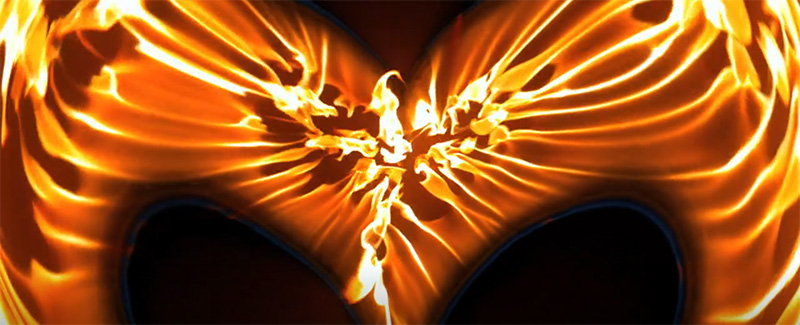Movies and TV
Adrenochrome and Ritual Humiliation: The True Meaning of the Movie “The Substance”
“The Substance” is about an aging Hollywood actress who consumes a black market product that promises her a “younger, more beautiful, more perfect” version. The occult elite has been obsessed with this for centuries. Here’s a look at the symbolism in this bizarre movie.

Warning: Disgusting spoilers ahead!
Hailed as a “feminist masterpiece,” The Substance gained notoriety for scenes so gory that they reportedly caused people to walk out of theatres. That’s some pretty good publicity for a body horror movie. The hype continued as The Substance also won Best Screenplay at Cannes while enjoying a constant flow of rave reviews from media critics.
But then more people watched the movie, and many found it grating, nonsensical, and in total opposition to its supposed feminist message. So, who’s right about The Substance?
Well, there’s one thing we need to know about mass media critics: They praise movies based on agendas, not on inherent quality. And they love toxic, debased stories that are justified due to “feminism.” For instance, the 2023 movie Poor Things recently won numerous accolades (including Oscars) because of its supposed feminist message. In actuality, it is about a child in a woman’s body having sex with older men.
Oddly enough, the actress Margaret Qualley stars in both Poor Things and The Substance, and, in both cases, she plays the role of an ungodly mutation of a human being.
In The Substance, Margaret Qualley plays Sue, a younger and hotter version of Elizabeth Sparkle (played by Demi Moore), an aging Hollywood star. Sue came into existence because Sparkle injected herself with an illicit, black-market product that promised a “younger, more beautiful, more perfect” version of herself.
This premise led many to wonder: Is this movie about adrenochrome, that mysterious substance rumored to be consumed in elite circles for youth and vitality?
An Old Obsession

This promotional poster shows a syringe containing the substance standing between the main protagonist’s old and new self. The starry shape on the tip of the syringe alludes to the process’ supernatural component.
The Substance revolves around an age-old theme: the search for eternal youth. Since the dawn of time, people have been trying to stop and reverse the ravages of time on the human body. However, this process always comes at a cost.
Stories of eternal youth often involve selling one’s soul in a Faustian deal with the devil. On a spiritual level, one can argue that unnaturally reversing the aging process means going against God’s will. The quest for youth gets darker when one understands that it nearly always involves extracting blood or other fluids from younger specimens to be injected into the older ones. Throughout history, sadistic practices involving blood, sacrifices, and cannibalism have always preyed on the potency of youth to regenerate an aging body.
The story of Elizabeth Bathory, a 17th-century Hungarian noblewoman dubbed “The Blood Countess,” proves that the occult elite had been dabbling with this concept for centuries. Said to be obsessed with her looks and jealous of younger women, Bathory has infamously abducted hundreds of virgins, tortured them, and extracted their blood to bathe in it or to consume it outright. The process also involved bizarre satanic rituals.

A classic depiction of Elizabeth Bathory indulging in the blood of young women.
Interesting fact: The main character of The Substance is named Elizabeth.
To this day, there are talks about the occult elite preserving youth through horrific methods. For instance, a “substance” named adrenochrome is said to be consumed by the occult elite to preserve youth. Most potent when extracted from young children, adrenochrome is believed to be farmed in facilities where victims are detained, abused, and tortured. Chillingly enough, some claim that adrenochrome levels spike in children while in a state of fear and terror.
In 2023, a French personality named Gérard Fauré stated on national television that celebrities like Celine Dion regularly consume adrenochrome. When asked where the substance comes from, Fauré replied that more than one-third of missing children in France are never found. French media went into full meltdown mode in the days that followed.
The Substance was created by French movie maker Coralie Fargeat, who has been in the industry for decades. Is the “substance” in her movie inspired by these talks of adrenochrome? Is the elite telling us, through gore and “feminism,” what actually happens behind closed doors?
Here’s a look at the movie.
The Real Substance
Numerous critics stated that, despite its name, The Substance severely lacks substance, and its major plot points do not make sense. In interviews, Fargeat noted that most of the story is not conveyed through dialog but through symbolism. Indeed, through visual cues and references, the movie goes beyond feminism to describe an occult transformation.
The movie begins with a scene that visually explains how the substance works.

An egg yolk is injected with the substance.

The yolk divides itself and creates a newer version of itself. As we’ll see, the protagonists are associated with food throughout the movie.
The movie then introduces viewers to actress Elizabeth Sparkle. The rise and fall of her career is explained through a timelapse of her star on the Hollywood Walk of Fame.

While people used to take pictures with Elizabeth Sparkle’s star, she is now old and irrelevant. To symbolize this fact, her star is cracked, and this guy spills his lunch all over it.
Elizabeth Sparkle is an Oscar-winning actress whose movie career dried up as she aged. Not unlike Jane Fonda and other real-life actresses, Sparkle turned to aerobics videos to keep her career going.

On numerous occasions, Elizabeth and, later, her younger self walk through this red hallway. The promotional posters represent the state of their careers.
On her 50th birthday, Sparkle’s boss decided it was time to fire her because she was too old. He needed someone “hot and young” to replace her.

The producer of Sparkle’s show is named Harvey—a not-so-subtle reference to disgraced Hollywood producer Harvey Weinstein. While firing her, Harvey disgustingly eats a bunch of shrimp because he’s the bad guy.
Strange fact: Harvey is played by Dennis Quaid. He’s the brother of Randy Quaid, who infamously fled Hollywood, claiming that a shadowy group of “star whackers” was assassinating celebrities in Hollywood. Meanwhile, his brother Dennis plays the role of a sleazy producer in a movie about an adrenochrome-like substance.
While the movie could have tackled the universal theme of aging in several interesting ways, it chose to take the lamest shortcut, one that prevents any meaningful reflection.

It’s because of old white men. They’re why there are hot people on TV and in movies. Shame.
From then on, Elizabeth is not a vain, privileged woman willing to do anything to stay in the spotlight. She is a victim of old white men, and nothing she does is her fault. Her quest for eternal youth and hotness is now about empowerment. That’s a great way of rationalizing the usage of adrenochrome.
Let’s say we agree with this feminist premise. Then, what about the biggest male movie stars? What do Leonardo DiCaprio, Brad Pitt, George Clooney, and Johnny Depp have in common? The obvious answer: Women think they’re very hot. Is it possible that humans prefer watching attractive, photogenic people on screens? Is it truly an old white man thing or a universal human thing?
In any case, The Substance decided to go with this faulty premise, and the media thought it was genius. However, as we’ll see, the actual “substance” of the movie resides elsewhere—deeply ingrained in symbolism, as it ultimately doesn’t even bother to make its feminist premise make sense.
So, after being fired, Elizabeth goes home feeling worthless.

While driving, Elizabeth sees workers removing her billboard, turning it into a one-eye sign. There are a few others in the movie, a subtle way of highlighting the ritualistic dimension of the movie.
Later, Elizabeth learns about the substance—a black market product that could solve her problems—so she goes out and gets it.

The substance is so illicit that Elizabeth needs to go to a hidden and highly secure location to obtain it. What’s in that substance? Children’s blood? Would they need to hide it if it was made from aloes?

The package includes the mysterious substance and food for the “matrix” and “the other self.” As we’ll see, the substance doesn’t merely reverse the aging process; it creates an entirely different self.
When Elizabeth injects herself with the substance, we see a series of quick images with symbolic meaning.

After the injection, we briefly see Elizabeth with two eyeballs, hinting at the creation of a second consciousness.
The occult elite loves this imagery as it was used in the past with other celebrities.

This is a screenshot from Britney Spears’ 2011 video “Hold it Against Me.”As explained in this article, it is one of the most blatant videos about creating an alter-persona.
Through symbolism, we understand that the substance does not merely make one younger: It is an occult process that “gives birth” to a separate alter-persona.

This image quickly flashes during Elizabeth’s transformation. It depicts a phoenix rising from its ashes – an important symbol in occultism.
In a rather gory scene, Elizabeth “gives birth” (through her back) to the new her: Sue. While Elizabeth is 50, Sue is about half her age.

Sue (played by Margaret Qualley) is a younger version of Elizabeth, and everyone loves her better for it.
The substance works with a perplexing caveat: Sue can only exist while Elizabeth is in a dormant state and vice versa. This means that Sue exists independently from Elizabeth. So, what’s the point of doing all of this?

Sue replaces Elizabeth on her aerobics show, making it younger and sexier … to an absurd degree.
The plot doesn’t appear to be fully thought out from a logical standpoint. However, from an occult elite standpoint, it serves a bizarre trend in the movie industry.
Humiliation Ritual
In many ways, The Substance is reminiscent of the aforementioned Poor Things, a movie with repulsive scenes and a message contradictory to its “feminist” viewpoint. In my article about Poor Things, I explained that it was less about communicating an “empowering” message and more about having Emma Stone act out a series of highly sexual and often degrading scenes. In the article, I wrote:
“The movie’s insistence on depicting sex scenes involving the actress takes on a ritualistic dimension where she’s being initiated through humiliation.”
The Substance accomplishes the same bizarre function with actresses Demi Moore and Margaret Qualley. Like in Poor Things, both main actresses perform in extreme and degrading scenes that often involve extended nudity.

Most of Qualley’s scenes involve close-up shots of her butt or chest, as she’s continually compared to a piece of meat.
Strange fact: Margaret Qualley wore prosthetics to enhance her breasts during shooting. That’s very ironic. The makers of this “feminist masterpiece” looked at Qualley and said: “We need bigger boobs.”
According to interviews, the process of hyper-sexualizing Qualley’s character was a mortifying experience for the actress.
“Margaret Qualley described learning the choreography for The Substance as a “nightmare,” and was overwhelmed by performing with professional dancers who had already memorized the moves which she was new to. Although trained as a ballet dancer, she explained that “that specific kind of sexuality doesn’t lend itself to [me]” and that she’d “never [do it] again.”
Qualley began the rehearsal with Fargeat present but left the set to go to the bathroom and cry. Fargeat decided to leave the rehearsal as well, and later, Qualley received a private one on one lesson, allowing her to practice in her hotel room and build confidence as she felt deeply ashamed by the whole series of events. Nonetheless, on the day of the shoot, she “just got wasted first thing in the morning” because she was anxious about performing in front of everyone; a combination of cannabis and tequila gave her the courage she needed.”
So, the director of The Substance had Maraget Qualley perform in scenes so sexual that they caused her to cry because they went against her very nature. To overcome this fear, she had to be heavily intoxicated. Hollywood loves to create roles that require the humiliation and the debasement of actresses for all to witness.
Meanwhile, Demi Moore is humiliated in the opposite matter. Throughout the movie, her aging body and facial features are constantly highlighted and brutally contrasted with her younger version, to the point that it feels like a ritual humiliation.

While viewers are forced to look at Sue’s perfect butt and boobs, they are also forced to focus on Elizabeth’s wrinkles and sagginess. While the camera is flattering (if not lustful) towards Sue, it is brutal towards Elizabeth. This process must have been rather humbling to Demi Moore.
Elizabeth’s character has no backstory, and the entire movie contains minimal dialog, emphasizing the sentiment that this is actually about Demi Moore and how she’s past her prime.

Disgusted with herself, Elizabeth threw a trophy at her large framed picture. The result: Another one-eye sign. The message: This movie is about occult elite weirdness.
While the movie aims to highlight the differences between Sue and Elizabeth, it also appears to humiliate Demi Moore personally.

A box says “Old junk Elizabeth” – a not-so-subliminal way of saying that Elizabeth IS old junk,

When Elizabeth gets flowers after being fired, the note says “you were amazing”. The past tense means that she belongs in the past.

Conversely, later in the movie, Sue receives flowers that say, “They are going to love you.” The future tense means she still has a bright future ahead of her.
Through the sexualization of Sue and the humiliation of Elizabeth, The Substance ends up treating both actresses as lumps of flesh who are defined by their exterior appearance. Appropriately enough, the movie constantly compares them to food.
The Food Theme

When Elizabeth “gives birth” to Sue, their naked bodies are briefly juxtaposed to two frying eggs.
The concept of food is constantly present throughout The Substance. Not unlike the characters themselves, food is always presented in a crude and gross manner, as the movie intentionally wants to turn what is usually appetizing into something disgusting. Furthermore, the movie constantly compares the characters to food, which gives the story a “cannibalistic” feel.

As she watches Sue on television, an aging Elizabeth obsessively cooks meals with gory names.

In one shot, Elizabeth intensely grabs a turkey leg.

In the next shot, Sue’s tighs are presented in a “meat-like” fashion. She’s dehumanized.

The cooking instructions appear to be aimed at Sue.
At one point, the man who introduced Elizabeth to the substance asks her:
“Has she started yet? Eating away at you?”
To remain “awake” for longer periods of time, Sue “eats away at Elizabeth” by forcing her to stay dormant longer. This causes the aging actress to age even faster as she is malnourished.

Sue “drains” Elizabeth until she turns into an old, bald, and hunchbacked lady. Yes, that’s Demi Moore on the right – more humiliation.
In The Substance, the characters are merely lumps of flesh from which lifeforce can be extracted. That’s what cannibalism, adrenochrome, and blood rituals are about. Speaking of which, the movie’s climax is one big blood ritual.
I will spare you the gory details of the ending, but it has something to do with Sue/Elizabeth turning into a disgusting human abomination that spills blood on everyone. Apparently, there’s a feminist message in there. Or maybe it’s an excuse to subject viewers to a lot of blood.

The movie culminates with gallons of blood being splattered all over the audience of a theatre. The occult elite loves to show people drenched in blood as they like to do this behind closed doors.

Although unnecessary, those who made the movie found it essential to drench a child with blood.
The movie ends with a symbolic scene summarizing The Substance‘s message.

Reduced to a lump of goo, Elizabeth finds her way to her Hollywood star, where she ultimately dissolves and disappears.
What should we take away from all of this? Aging Hollywood actresses are the most oppressed demographic in the world. They get slightly less attention when they become old, and that’s the worst thing that could happen in the world.
In Conclusion
In The Substance, a young actress is sexualized, fetishized, and gazed upon to an absurd degree. Meanwhile, another actress has to exhibit the features of her aging body to a brutal, unforgiving camera. While the movie is meant to be satirical, it ultimately perpetuates the very thing it is supposed to be denouncing.
That’s because, in the end, the “feminist” message of The Substance is merely a facade meant to lead short-sighted critics down a dead-end path. The true message of The Substance can be found in the dark mindset of the elite that rules Hollywood. Through gore and nudity, The Substance tells a story of It is about vanity, self-absorption, exploitation, ritualistic humiliation, and the consumption of human substances to achieve youth. Moreover, although I did not dwell on those scenes, The Substance features long, drawn-out scenes of bloody, unhinged depravity that make one realize that those who made this are deeply deranged.
In short, this movie is another case of normalizing evil through “feminism.” That is why mass media loved it. They want us to soak in toxicity the same way the audience got soaked in blood during The Substance‘s climatic scene.
- Lindsey Horvath, Celtic Goddess Brigid and the Los Angeles fires.
- Denzel Washington for Herb Ritts #1 (circa 1990)
- Denzel Washington for Herb Ritts #2 (circa 1990)
- Denzel Washington for Herb Ritts #3 (circa 1990)
- The war on children wages on … modern day Marquis de Sade.
- NBC was Harvey Weinstein’s accomplice
- No self awareness detected
Get an e-mail notification as soon as a new article is published on The Vigilant Citizen.
-

 Pics of the Month3 months ago
Pics of the Month3 months agoSymbolic Pics of the Month 10/24
-

 Movies and TV3 months ago
Movies and TV3 months agoAn In-Depth Look at the Hidden Meaning and Symbolism in “Blink Twice”
-

 Latest News2 months ago
Latest News2 months agoKamala’s Campaign Was Objectively the Worst in Recent History
-

 Pics of the Month1 month ago
Pics of the Month1 month agoSymbolic Pics of the Month 12/24
-

 Latest News2 months ago
Latest News2 months agoWas the Jake Paul vs Mike Tyson Fight a Humiliation Ritual?
-

 Latest News2 months ago
Latest News2 months agoAn “Urban Opera” in Toulouse Using Massive Machines is Denounced as a Satanic Ritual
-

 Latest News1 month ago
Latest News1 month agoIt Was Bound to Happen: Jay-Z Accused of Abusing a 13-Year-Old Girl
-

 Latest News3 weeks ago
Latest News3 weeks agoReturn of the Pendulum: My 2024 Holiday Message

















